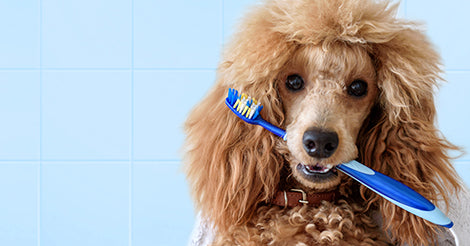
How to brush my dog's teeth?
Are you aware of your dog's dental health problems?
Periodontal disease is the most common dental problem in dogs. It is estimated that 70% - 80% of dogs over the age of three suffer from periodontal disease, an inflammation or infection of the tissues surrounding the teeth. Periodontal disease starts as gingivitis caused by plaque and often progresses to involve the bony tooth sockets. Left untreated, periodontal disease can lead to painful tooth loss. And the enormous amount of bacteria inside the mouth can even spread to other nearby tissues can lead to more severe infections in other organs.
Therefore, it is important to maintain and monitor your dog's dental health. Besides taking your dog to the vet for a dental checkup annually, you should also brush its teeth everyday. Here are some tips for you!
How often should I brush my dog's teeth?
Twice a day is the most ideal way, just like human. If you really do not have enough time for brushing your dog's teeth, do it at least twice a week.
How to choose the right tools?
Commercial toothbrushes are available that are specifically designed for use in dogs. These include:
- brushes with angled handles,
- brushes with multiple heads (so that you can simultaneously brush the inside, outside and top surfaces of the tooth),
- small brushes that fit comfortably in your hand, and
- finger toothbrushes (designed to fit over the tip of your finger).

Do I need to use a toothpaste?
Yes, and be reminded that you must only use a pet toothpaste. Ingredients of human toothpaste can cause an upset stomach or digestive disturbances in dogs.
Go look for a toothpaste that has good cleaning effect and is safe for your dog here.
How to brush exactly?
1. Apply a small amount of toothpaste to the toothbrush.
2. Gently raise your dog's lips on one side.

3. Start brushing. Put your efforts on the outer surfaces of the teeth where periodontal lesions occur. At the beginning, concentrate on brushing the large cheek teeth and the canine teeth, the teeth where plaque and tartar accumulate most quickly.
4. Allow some times for your dog to get used to teeth brushing, then you can brush all the teeth.
5. Divide your dog's teeth into 6 regions: Upper and lower region for left, middle and right. For each region, brush it for 5-10 times.
What else can I do to maintain my dog's dental health?
A list of dental products and diets that have been accepted by the Veterinary Oral Health Council can be found on www.vohc.org. These accepted products have been shown to decrease the accumulation of plaque and/or tartar by at least 20%.
Go shop for some dental products here.






